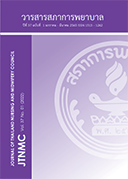Predictors of Older Patients’ Stay in the Emergency Department
Keywords:
older patients, comorbidity, night shift, hospitalisation, length of stay at the emergency departmentAbstract
Objective: To examine the predictive power that each of these factors had on older patients’ length of stay in the emergency department: sex, age, comorbidity, right to medical service, severity of the emergency, shift during which service was received, crowdedness, and discharge status
Design: Predictive correlational research
Methodology: The researcher recruited a sample of 113 patients, all of whom were aged 60 years or older, treated for non-trauma conditions in the emergency department, and with the emergency severity level of 2- 4, at a large tertiary hospital in Bangkok. Data were collected during January to April 2021 using the Demographic and Clinical Profle, the Charlson Comorbidity Index, the EDWIN Score, the Emergency Severity Index (version 4), and the Length of Stay in ED form. The data were analysed using descriptive statistics and binary logistic regression.
Results: The majority of the patients (55.8%) were females with an average age of 72.83 (SD = 9.12) and an average of 17 hours and 18 minutes of treatment time in the emergency department. Over three-fourths of the patients (77%) received four or more hours of treatment in the emergency department. The factors of sex (male), comorbidity, receipt of treatment during a night shift, and hospitalisation effectively predicted the need for four or more hours of treatment in the emergency department, with a variance of 33.5 (Nagelkerke R2 = 0.335), at 3.183, 1.490, 0.169, and 8.664 times, respectively.
Recommendations: The study fndings could be utilised as supporting data for nursing care for older patients in the emergency department. It is recommended that nurses pay special attention to hospitalised older male patients with comorbidities, to ensure their timely treatment and reduce their length of stay in the emergency department.
Downloads
References
Samaras N, Chevalley H, Samaras D, Gold G. Older patients in the emergency department: a review. Ann Emerg Med. 2010;56(3):261-9. doi: 10.1016/j.annemergmed.2010.04.015.
Ashman JJ, Schappert SM, Santo L. Emergency department visits among adults aged 60 and over: United States, 2014-2017. NCHS data brief. 2020(367):1-8
Somton A. Annual report 2019-2020. National Institute for Emergency Medicine. [cited 2020 June 4]. Available from: https://ws.niems.go.th/ITEMS_DWH/.
Gilboy N, Tanabe P, Travers D, Rosenau AM. Emergency Severity Index (ESI): a triage tool for emergency department care, Version 4. Implementation Handbook 2012 Edition: Rockville, MD: Agency for Healthcare Research and Quality; 2011. [cited 2020 August 1] Available from: https://www.ahrq.gov/ sites/default/fles/wysiwyg/ professionals/systems/hospital/esi/esihandbk.pdf.
Street M, Mohebbi M, Berry D, Cross A, Considine J. Influences on emergency department length of stay for older people. Eur J Emerg Med. 2018;25(4):242-9. doi: 10.1097/MEJ.0000000000000452.
Sweeny A, Keijzers G, O’Dwyer J, Arendts G, Crilly J. Predictors of a long length of stay in the emergency department for older people. Intern Med J. 2020; 50(5):572-81. doi: 10.1111/imj.14441.
Arendts G, Lowthian J. Demography is destiny: an agenda for geriatric emergency medicine in Australasia. Emerg Med Australas. 2013;25(3):271-8. doi: 10.1111/1742-6723.12073.
Perdahl T, Axelsson S, Svensson P, Djärv T. Patient and organizational characteristics predict a long length of stay in the emergency department - a Swedish cohort study. Eur J Trauma Emerg Surg. 2017;24(4):284-9. doi: 10.1097/mej.0000000000000352.
Ackroyd-Stolarz S, Read Guernsey J, Mackinnon NJ, Kovacs G. The association between a prolonged stay in the emergency department and adverse events in older patients admitted to hospital: a retrospective cohort study. BMJ Qual Saf. 2011;20(7):564-9. doi: 10.1136/bmjqs.2009.034926
Bashkin O, Caspi S, Haligoa R, Mizrahi S, Stalnikowicz R. Organizational factors affecting length of stay in the emergency department: initial observational study. Isr J Health Policy Res. 2015;4:38. doi: 10.1186/s13584-015-0035-6
Latham LP, Ackroyd-Stolarz S. Emergency department utilization by older adults: a descriptive study. Can Geriatr J. 2014;17(4):118-125. doi: 10.5770/cgj. 17.108.
Sullivan C, Staib A, Khanna S, Good NM, Boyle J, Cattell R, et al. The National Emergency Access Target (NEAT) and the 4-hour rule: time to review the target. Med J Aust. 2016;204(9):354-9. doi: 10.5694/mja15.01177
Ministry of Public Health. Indicator details Ministry of Health 2019-2020. [cited 2020 August 1].Available from: https://bps.moph.go.th/new_bps/sites/default/fles/template62_edit3.pdf.
Ye L, Zhou G, He X, Shen W, Gan J, Zhang M. Prolonged length of stay in the emergency department in high-acuity patients at a Chinese tertiary hospital. Emerg Med Australas. 2012;24(6):634-40. doi:110.1111/j.1742-6723.2012.01588.
Hosseininejad SM, Aminiahidashti H, Pashaei SM, Goli Khatir I, Montazer SH, Bozorgi F, et al. Determinants of prolonged length of stay in the emergency department; a cross-sectional study. Emerg (Tehran). 2017;5(1): e53.
Wibulpolprasert A, Sittichanbuncha Y, Sricharoen P, Borwornsrisuk S, Sawanyawisuth K. Factors associated with overcrowded emergency rooms in Thailand: a medical school setting. Emerg Med Int. 2014; 2014:576259. doi: 10.1155/2014/576259.
Lenghong K. Factors affecting length of stay more than 4 hours in the emergency department of Srinagarind Hospital. Srinagarind Medical Journal. 2014;29(1): 7-13. (in Thai)
Sir Ö, Hesselink G, Van Den Bogaert M, Akkermans RP, Schoon Y. Risk Factors for prolonged length of stay of older patients in an academic emergency department: a retrospective cohort study. Emerg Med Int. 2019; 2019:4937827. doi: 10.1155/2019/4937827.
Goluke N, Huibers CJA, Stalpers SC, Taekema DG, Vermeer SE, Jansen PAF. An observational, retrospective study of the length of stay, and its influencing factors, among elderly patients at the Emeof rgency Department. Eur Geriatr Med. 2015;6:331-5. doi: 10.1002/ams2.403.e
Jiamprasert S, Hurst C, Sriprajittichai P. Factors associated with length of stay of non-trauma patients in the Emergency department: a cross-sectional study in Thai healthcare setting. Journal of Medical Association of Thailand 2017;100:1232. (in Thai)
Donabedian A. Evaluating the quality of medical care. Milbank Q. 2005;83(4):691-729.
Casalino E, Wargon M, Peroziello A, Choquet C, Leroy C, Beaune S, et al. Predictive factors for longer length of stay in an emergency department: a prospective multicentre study evaluating the impact of age, patient’s clinical acuity and complexity, and care pathways. Emerg Med J. 2014;31(5):361-8. doi: 10.1136/emermed-2012-155.
Dadashzadeh A, Abdollahzadeh F, Vahdati SS, Lotf M, Ghojazadeh M, Mehmandousti SB. Causes of delay in patient triage in the emergency departments of Tabriz hospitals. Turk J Emerg Med. 2011;11(3):95-8. doi: 10.5505/1304.7361.2011.59354.
Plichta SB, Kelvin EA. Munro’s statistical methods for health care research. 6th ed. Philadelphia: Lippincott Williams & Wilkins; 2013.
Charlson ME, Charlson RE, Peterson JC, Marinopoulos SS, Briggs WM, Hollenberg JP. The Charlson comorbidity index is adapted to predict costs of chronic disease in primary care patients. J Clin Epidemiol. 2008; 61(12):1234-40.
Bernstein SL, Verghese V, Leung W, Lunney AT, Perez I. Development and validation of a new index to measure emergency department crowding. Acad Emerg Med. 2003;10(9):938-42. doi: 10.1111/ j.1553-2712.2003.tb00647.
Sinapidis D, Kosmas V, Vittoros V, Koutelidakis IM,Pantazi A, Stefos A, et al. Progression into sepsis: an individualized process varying by the interaction of comorbidities with the underlying infection. BMC Infect Dis. 2018;18(1):242. doi: 10.1186/s12879-018-3156-z.
Foundation of Thai Gerontology Research and Development Institute. Situation of the Thai elderly 2016 [Internet]. 1st ed. Bangkok: October print; 2016. [cite 2020 Jul 7]. Available from: http://www.dop.go.th/download/knowledge/th1512367202-108_0.pdf.
Rajavithi Hospital. Statistical report 2018. [cited 2020 June 6]. Available from: http://www.rajavithi.go.th/rj/wp-content/uploads/2019/09/stat2561.pdf.
Downloads
Published
How to Cite
Issue
Section
License
Copyright (c) 2022 Thai Journal of Nursing Council

This work is licensed under a Creative Commons Attribution-NonCommercial-NoDerivatives 4.0 International License.








